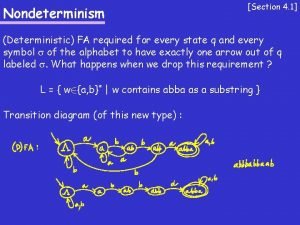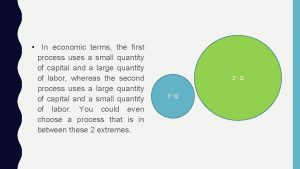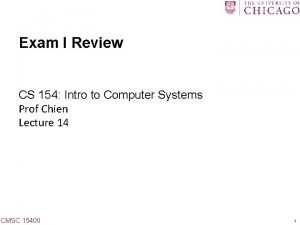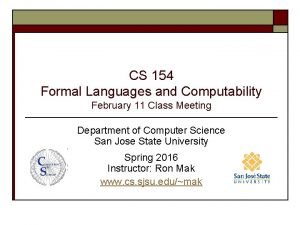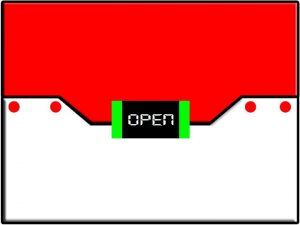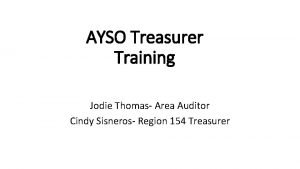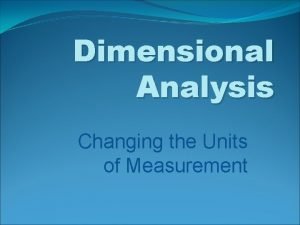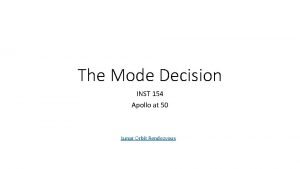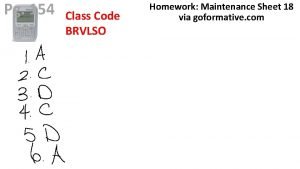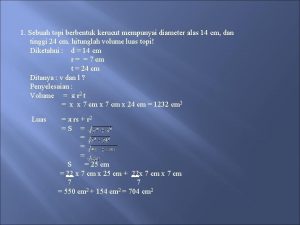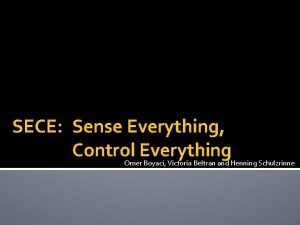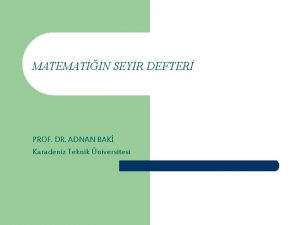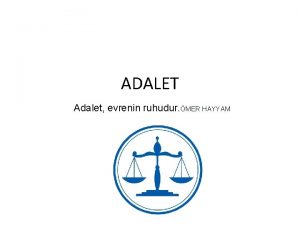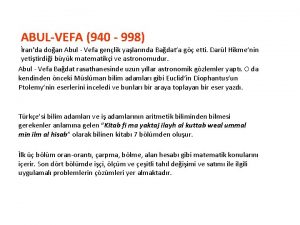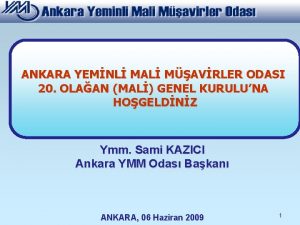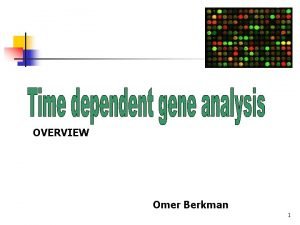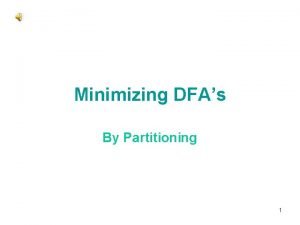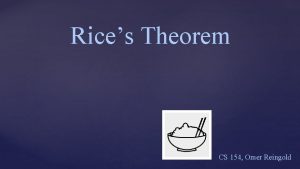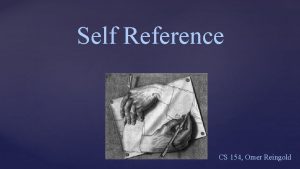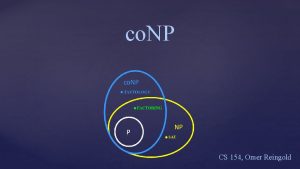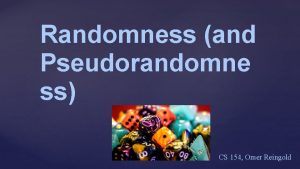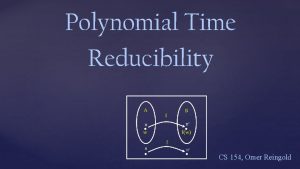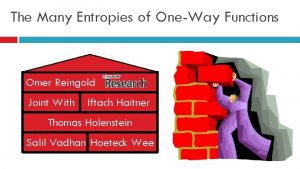Minimizing DFAs CS 154 Omer Reingold Does this







































- Slides: 39

Minimizing DFAs CS 154, Omer Reingold

Does this DFA have a minimal number of states?


Is this minimal? How can we tell in general?

Theorem: For every regular language L, there is a unique (up to re-labeling of the states) minimal-state DFA M* such that L = L(M*). Furthermore, there is an efficient algorithm will output this unique M*. which, given any DFA M, If these were true for more general models of computation, that would be an engineering breakthrough

Note: There isn’t a uniquely minimal NFA

Extending transition function to strings Given DFA M = (Q, Σ, , q 0, F), we extend to a function : Q Σ* → Q as follows: (q, ε) = q (q, ) = (q, ) (q, 1 … k+1 ) = ( (q, 1 … k ), k+1 ) (q, w) = the state of M reached after reading in w, starting from state q Note: (q 0, w) F M accepts w Def. w Σ* distinguishes states q 1 and q 2 if exactly (q (q (q 1, w)one Fof (q 2 F, w) is a final state 1, w), 2, w)

Distinguishing two states Def. w Σ* distinguishes states q 1 and q 2 if exactly one of (q 1, w), (q 2, w) is a final state I’m in q 1 or q 2, but which? How can I tell? Ok, I’m accepting ! Must have been q 1 Here… read this W

Fix M = (Q, Σ, , q 0, F) and let p, q Q Definitions: State p is distinguishable from state q if there is w Σ* that distinguishes p and q ( there is w Σ* so that exactly one of (p, w), (q, w) is a final state) State p is indistinguishable from state q if p is not distinguishable from q ( for all w Σ*, (p, w) F (q, w) F) Pairs of indistinguishable states are redundant…

Which pairs of states are distinguishable here? ε distinguishes all final states from non-final states

Which pairs of states are distinguishable here? The string 10 distinguishes q 0 and q 3

Which pairs of states are distinguishable here? The string 0 distinguishes q 1 and q 2

Fix M = (Q, Σ, , q 0, F) and let p, q, r Q Define a binary relation ∼ on the states of M: p ∼ q iff p is indistinguishable from q p ≁ q iff p is distinguishable from q Proposition: ∼ is an equivalence relation p ∼ p (reflexive) p ∼ q q ∼ p (symmetric) p ∼ q and q ∼ r p ∼ r (transitive) Proof?

Fix M = (Q, Σ, , q 0, F) and let p, q, r Q Therefore, the relation ∼ partitions Q into disjoint equivalence classes Proposition: ∼ is an equivalence relation [q] : = { p | p ∼ q }


Algorithm: MINIMIZE-DFA Input: DFA M Output: DFA MMIN such that: L(M) = L(MMIN) MMIN has no inaccessible states MMIN is irreducible || For all states p q of MMIN, p and q are distinguishable Theorem: MMIN is the unique minimal DFA that is equivalent to M

Intuition: The states of MMIN will be the equivalence classes of states of M We’ll uncover these equivalent states with a dynamic programming algorithm

The Table-Filling Algorithm Input: DFA M = (Q, Σ, , q 0, F) Output: (1) DM = { (p, q) | p, q Q and p ≁ q } (2) EQUIVM = { [q] | q Q } High-Level Idea: • We know how to find those pairs of states that the string ε distinguishes… • Use this and iteration to find those pairs distinguishable with longer strings • The pairs of states left over will be indistinguishable

The Table-Filling Algorithm Input: DFA M = (Q, Σ, , q 0, F) Output: (1) DM = { (p, q) | p, q Q and p ≁ q } (2) EQUIVM = { [q] | q Q } Base Case: For all (p, q) such that p accepts and q rejects p ≁ q

The Table-Filling Algorithm Input: DFA M = (Q, Σ, , q 0, F) Output: (1) DM = { (p, q) | p, q Q and p ≁ q } (2) EQUIVM = { [q] | q Q } Base Case: For all (p, q) such that p accepts and q rejects p ≁ q Iterate: If there are states p, q and symbol σ Σ satisfying: D D D (p, ) = p (q, ) = ≁ q mark p≁q Repeat until no more D’s can be added

D D D

D D D 22 D

Claim: If (p, q) is marked D by the Table-Filling algorithm, then p ≁ q Proof: By induction on the number of steps in the algorithm before (p, q) is marked D If (p, q) is marked D at the start , then one state’s in F and the other isn’t, so ε distinguishes p and q Suppose (p, q) is marked D at a later point. Then there are states p , q such that: 1. (p , q ) are marked D p ≁ q (by induction) So there’s a string w s. t. (p , w) F (q , w) F 2. p = (p, ) and q = (q, ), where Σ The string w distinguishes p and q!

Claim: If (p, q) is not marked D by the Table-Filling algorithm, then p ∼ q Proof (by contradiction): Suppose the pair (p, q) is not marked D by the algorithm, yet p ≁ q (call this a “bad pair”) Then there is a string w such that |w| > 0 and: (p, w) F and (q, w) F (Why is |w| > 0? ) Weallhave = w , forlet some w’ and Σ Of suchwbad pairs, p, qstring be a pair withsome the shortest distinguishing string w Let p = (p, ) and q = (q, ) Then (p , q ) is also a bad pair, but with a SHORTER distinguishing string, w !

Algorithm MINIMIZE Input: DFA M Output: Equivalent minimal-state DFA MMIN 1. Remove all inaccessible states from M 2. Run Table-Filling algorithm on M to get: EQUIVM = { [q] | q is an accessible state of M } 3. Define: MMIN = (QMIN, Σ, MIN, q 0 MIN, FMIN) QMIN = EQUIVM, q 0 MIN = [q 0], FMIN = { [q] | q F } MIN( [q], ) = [ ( q, ) ] Claim: L(MMIN) = L(M)

MINIMIZE

D D D D D

D D D D D

Thm: MMIN is the unique minimal DFA equivalent to M Claim: If L(M )=L(MMIN) and M has no inaccessible states and M’ is irreducible there is an isomorphism between M and MMIN Suppose for now the Claim is true. If M’ is a minimal DFA, then M’ has no inaccessible states and is irreducible (why? ) So the Claim implies: Let M’ be a minimal DFA for M. there is an isomorphism between output by MINIMIZE(M). The Thm holds! M’ and the DFA M MIN that is

Thm: MMIN is the unique minimal DFA equivalent to M Claim: If L(M )=L(MMIN) and M has no inaccessible states and M’ is irreducible there is an isomorphism between M and MMIN Proof: We recursively construct a map from the states of MMIN to the states of M Base Case: q 0 MIN �q 0 Recursive Step: If p �p q q Then q �q

Base Case: q 0 MIN �q 0 Recursive Step: If p �p q q Then q �q

Base Case: q 0 MIN �q 0 Recursive Step: If p �p q Then q �q q We need to prove: The map is defined everywhere The map is well defined The map is a bijection The map preserves all transitions: If p �p then MIN(p, ) � ’(p’, ) (this follows from the definition of the map!)

Base Case: q 0 MIN �q 0 Recursive Step: If p �p q Then q �q q The map is defined everywhere That is, for all states q of MMIN there is a state q of M such that q �q If q MMIN, there is a string w such that MIN(q 0 MIN, w) = q Let q = (q 0 , w). Then q �q

Base Case: q 0 MIN �q 0 Recursive Step: If p �p q Then q �q q The map is well defined Proof by contradiction. Suppose there are states q and q such that q �q and q �q We show that q and q are indistinguishable so it must be that q = q ,

Suppose there are states q and q such that q �q and q �q Suppose q and q are distinguishable MMIN v q 0 w q Reject q w q q 0 Contradiction! w Reject v u Accept q q 0 MIN w Accept u M

Base Case: q 0 MIN �q 0 Recursive Step: If p �p q Then q �q q The map is onto Want to show: For all states q of M there is a state q of MMIN such that q �q For every q there is a string w such that M’ reaches state q’ after reading in w Let q be the state of MMIN after reading in w Claim: q �q

The map is one-to-one Proof by contradiction. Suppose there are states p q such that p �q and q �q If p q, then p and q are distinguishable MMIN p q 0 MIN q q q 0 q Reject q 0 MIN w q 0 w Contradiction! v w Reject v u Accept w Accept u M

How can we prove that two regular expressions are equivalent?

Parting thoughts: DFAs can be optimized Later: Can DFAs be learned?
 Omer reingold
Omer reingold Omer reingold
Omer reingold Dfas organizational chart
Dfas organizational chart Nfas are ___ dfas.
Nfas are ___ dfas. Nih dfas
Nih dfas Dfas fein
Dfas fein Cost minimization formula
Cost minimization formula Cost minimizing rule
Cost minimizing rule Data system
Data system Uchicago cs 154
Uchicago cs 154 Cse 154
Cse 154 Cse 154
Cse 154 Cs 154 sjsu
Cs 154 sjsu Surah al baqarah 154-157
Surah al baqarah 154-157 Ordinul 154 din 2004
Ordinul 154 din 2004 Dodo akan memberi kado ulang tahun buat desi
Dodo akan memberi kado ulang tahun buat desi Senet-154
Senet-154 Equal protection for english language learners
Equal protection for english language learners Ayso nap online
Ayso nap online Grams to pounds dimensional analysis
Grams to pounds dimensional analysis Inst154
Inst154 Inst154
Inst154 Homework 154
Homework 154 Cs 154 stanford
Cs 154 stanford Sebuah kerucut mempunyai volume 20 cm3
Sebuah kerucut mempunyai volume 20 cm3 Omer morshed
Omer morshed Marco pistoia
Marco pistoia Aisha omer
Aisha omer Victoria sece
Victoria sece Sezgiciler
Sezgiciler Jean omer marie gabriel monnet
Jean omer marie gabriel monnet Adalet evrenin ruhudur sözü kime aittir
Adalet evrenin ruhudur sözü kime aittir ömer hayyam ın yaptığı çalışmalar
ömer hayyam ın yaptığı çalışmalar Omer yezdani
Omer yezdani Ymm mustafa soydemir
Ymm mustafa soydemir Omer boyaci
Omer boyaci Omer berkman
Omer berkman şehit ömer halisdemir anadolu lisesi obp puanı
şehit ömer halisdemir anadolu lisesi obp puanı Jean omer marie gabriel monnet
Jean omer marie gabriel monnet ömer hızıroğlu
ömer hızıroğlu



